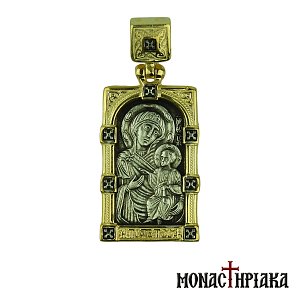Where is the Holy Monastery of Iviron and what position does it hold in the hierarchy?
On the north-eastern side of Athos is one of the oldest monasteries of Mount Athos. The Monastery of Iviron is an imposing Monastery that was founded at the end of the 10th century, shortly after the foundation of the Holy Monastery of Great Lavra and Holy Great Monastery of Vatopedi. Hierarchically, it ranks third among the other 20 monasteries of Mount Athos and celebrates the Dormition of the Virgin.
The monastic complex of the Iviron Monastery is majestic and impressive. The entrance to the Monastery is on the north side and the Catholic Church on the east side of the courtyard. Along the courtyard, the large spire, the “Trapeza” (=dining room) and the library building can be seen, making the courtyard an extremely beautiful space.
The wings surrounding the courtyard contain the monks' cells, the administration buildings, the tower, the manor and the guardrooms, organizing the monastery into an elaborate quadrilateral formation.
When was the Holy Monastery of Iviron founded and who is the founder
The Monastery of Iviron was originally founded in the 8th century and was known as the Monastery of Clement. However, in 980, a group of Georgian monks from the Great Lavra and under the guidance of the eminent monk John Tournikios, strengthened the monastery and made it a major power.
Ioannis Tornikios as a monk was called by the emperor of Byzantium Basil II and together they suppressed the rebellion of the general Barda Skleros (or Sclerus). From the spoils and the imperial donations, the oldest monastery of Clement was enlarged and the Monastery of Iviron was created. Saint Ioannis and his natural son Saint Euthymios - founder of the monastery and later abbot - emerged as enlighteners of the monks in Iviron monastery.
Thus, from 1010 onwards, the Monastery has its current name, in honor of its creators (Iberia was the name of the region of Georgia). Since then, many monasteries were attached to the Monastery, providing it with additional wealth and prosperity. Some of these monasteries are that of Leontios in Thessaloniki, Ioannis Kolovos in Ierissos, Saint Savvas of Chaldos and Kaspakos.

The Holy Monastery of Iviron through the ages: a short history
The Holy Monastery of Iviron did not escape challenges and disasters. Many attacks by pirates, mainly Franks, hit it during the 10th and 11th centuries.
In addition, at the beginning of the 15th century, the Monastery found itself in a difficult financial position, but with persistence, dedication and effort, it fully recovered at the end of the century. In this effort, the undivided support of the Paleologus emperors and the rulers of Serbia and Georgia played an important role. During that time, the Monastery gained new strength and recognition, while also acquiring several Greek monks.
Later, during the difficult times of the 16th century, many Georgian rulers benefited the Monastery and brought it out of its financial impasse.
During the 18th century, the Iberian Monastery experienced a long period of prosperity and development, thanks to the strong support from Georgian and Romanian rulers, as well as Ecumenical Patriarchs. However, in 1865 the monastery was almost completely destroyed by an uncontrollable fire, but it was quickly restored, preserving its architectural luxury and spiritual wealth.
During the Greek War of Independence of 1821, the Holy Monastery of Iviron provided significant financial assistance and supported the struggle until the end. In fact, the Patriarch and Ethnomartyr Gregory V, also spent some time in the Monastery, during his period of exile.
The chapels of the Monastery
The Holy Monastery of Iviron has 16 chapels, which impress with their frescoes, such as those of Saint Nikolaos and the Holy Archangels. The relics of 165 Saints are kept in the Catholicos, as well as pieces of the instruments used in the Crucifixion of the Lord.
In the courtyard of the monastery, there is the chapel of Saint John the Forerunner, built on top of the old Church of the Monastery of Clement. Also, the cemetery of the Monastery commemorates Saint Athanasios, patriarch of Alexandria, and is located to the north of the Monastery.

The sacred relics of the Iviron Monastery
What makes the Iviron Monastery special and important in the world of Orthodoxy is its sacristy and library. Some of the most important treasures of Mount Athos are kept in the monastery's sacristy.
Known relics of the Church are the famous lemon tree - a silver seven-light lamp - and the door from the exonarthex to the austere made of silver and ebony. Other known treasures of the Monastery are the so-called bag of John Tsimiskis, the priestly uniform of Patriarch Dionysios and the Great Gospel, a gift from Peter the Great.
Priceless artefacts, gold-embroidered vestments, church utensils and other unique sacred relics. In addition, it contains imperial and patriarchal documents, some of which are the chrysovuls of the emperors Michael II Palaiologos and John VI Kantakouzenos.
The library of the Monastery of Ibera
The library of the Monastery is very well organized and hides within it a rich treasure of knowledge. More than twenty thousand documents have been archived in the library, of which 33 are archetypes and 11,000 old printed books. In addition, more than 2300 manuscript codices are kept there, among them 223 parchments in the Greek and Georgian languages, as well as 14 liturgical scrolls.

The miraculous icon of Panagia Portaitissa
Panagia Portaitissa is an important religious and spiritual treasure for Mount Athos. The miraculous icon of Panagia Portaitissa is one of the most precious relics of the Monastery and protects the entire Mount Athos.
Next to the old entrance of the Monastery we find the chapel of Panagia Portaitissa, in which the miraculous icon of Panagia is kept. The holy icon is taken out of the chapel and transferred to the Catholic only during the festivities and a litany is held on Easter Tuesday.
How did the icon of Panagia Portaitissa arrive on Mount Athos?
According to tradition, during the period of the iconoclasm, many believers threw the holy icons into the sea to protect them from the iconoclasts. One of these images was precisely the Virgin Mary Portaitissa.
A pious woman in Nicaea threw the icon of the Virgin into the sea so that it would not be destroyed in the hands of enemies. The woman was overcome with feelings of sadness for the loss of the icon, but the Virgin Mary comforted her in her sleep, promising that the icon would reach a holy place and the faithful from all nations would worship it for centuries. Thus, with divine intervention, the icon miraculously appeared on Mount Athos in 1004 AD.
The icon miraculously floated upright on the sea and stood in front of the Holy Monastery of Iviron. The monks who were there tried reverently to catch the icon and pull it out of the sea, but all efforts were in vain. It seemed as if an invisible force was not allowing the image to approach.

This mystery was solved with the appearance of Virgin Mary to a monk named Gabriel, who was ascetic at a higher altitude, on a hill above the Monastery. Virgin Mary appeared in front of him and asked him to carry the icon to the Monastery himself, with the following words: "I want you to pick up my icon from the sea because I find you worthy to carry it to the Monastery".

The monk Gabriel obeyed the will of the Virgin Mary and received the icon from the sea. Incredible admiration flooded the hearts of the other monks, as the monk Gabriel miraculously walked on the waves of the sea and took the holy icon. As soon as the monk Gabriel touched the icon, holy water began to flow from that point.
The monk Gabriel together with the other monks of the Monastery and the abbot, transferred the icon of Panagia Portaitissa to the Church of the Monastery and placed it in the center, in a prominent position.
The next day, however, the icon was found again outside the monastery. Each time it was moved inside, the image returned to its original position. The monks, recognizing the will of the Virgin Mary, realized that the icon wanted to remain near the gate.
Making this event a point of reference and motivation of spiritual strength, the monks decided to build a chapel next to the gate of the Monastery to house the icon. There, the icon of Panagia Portaitissa stands proudly as the protector and guardian of all the monks of Mount Athos.
The festive days, as well as the litany ceremony of the image of the Virgin Portaitissa, gather believers and pilgrims from various regions, giving a special spiritual and festive atmosphere to Mount Athos. The icon of Our Lady Portaitissa is a symbol of faith, love and hope for the faithful and continues to attract believers from all over the world who seek to find spiritual solace in the monastic state of Mount Athos.
Contact with Iviron Monastery:
Phone: +30 23770 23643, +30 23770 23248
Email: imiviron@gmail.com
















